教案 综合英语II教案
- 格式:doc
- 大小:318.72 KB
- 文档页数:70
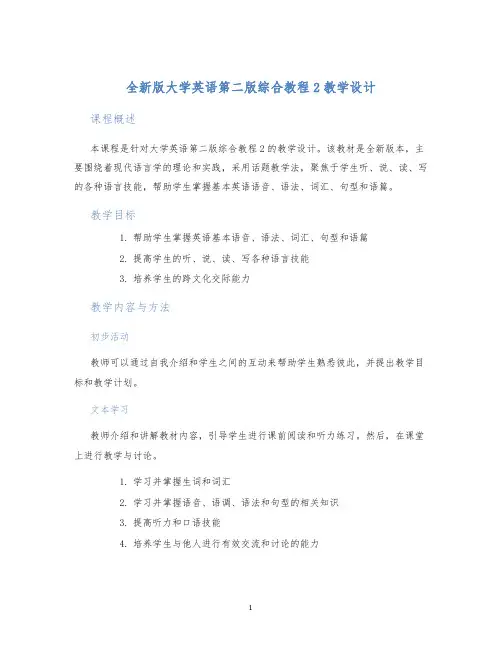
全新版大学英语第二版综合教程2教学设计课程概述本课程是针对大学英语第二版综合教程2的教学设计。
该教材是全新版本,主要围绕着现代语言学的理论和实践,采用话题教学法,聚焦于学生听、说、读、写的各种语言技能,帮助学生掌握基本英语语音、语法、词汇、句型和语篇。
教学目标1.帮助学生掌握英语基本语音、语法、词汇、句型和语篇2.提高学生的听、说、读、写各种语言技能3.培养学生的跨文化交际能力教学内容与方法初步活动教师可以通过自我介绍和学生之间的互动来帮助学生熟悉彼此,并提出教学目标和教学计划。
文本学习教师介绍和讲解教材内容,引导学生进行课前阅读和听力练习。
然后,在课堂上进行教学与讨论。
1.学习并掌握生词和词汇2.学习并掌握语音、语调、语法和句型的相关知识3.提高听力和口语技能4.培养学生与他人进行有效交流和讨论的能力在这个阶段,学生将与同伴进行对话和讨论来练习他们的交际技能和口语能力。
1.分组讨论和答案2.听力练习,然后对话3.角色扮演任务设置通过任务来提醒学生想关掌握的语言技能,并通过小组讨论来实现任务目标。
常见的任务包括:1.填空2.听力选择练习3.阅读理解评估与反馈在整个课程中,评估和反馈非常重要。
教师可以通过出题或其他方法来考察学生对知识的掌握程度,给予及时的反馈。
例如,教师可以组织小组活动,让学生之间互相评估,互相帮助,并在最后对学生的表现进行总结和评估。
教学策略任务型教学全新版大学英语第二版综合教程2采用话题教学法,并运用了任务型教学,强调学生的自主学习和学习者中心。
探究性学习教师引导学生进行自我学习和探究,帮助学生掌握更多的知识和技能。
教师可以根据学生的不同需求和能力,调整教学方法和进度,帮助学生实现个性化学习。
总结全新版大学英语第二版综合教程2的教学设计,旨在帮助学生掌握英语基本语音、语法、词汇、句型和语篇,提高听力、口语、阅读、写作技能,并培养学生的跨文化交际能力。
教学方法包括任务型教学、探究性学习和个性化学习,旨在激发学生的学习兴趣,提高学习效率。
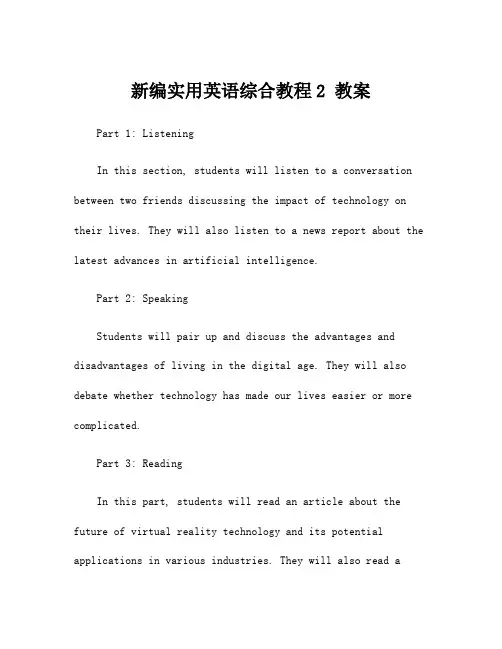
新编实用英语综合教程2 教案Part 1: ListeningIn this section, students will listen to a conversation between two friends discussing the impact of technology on their lives. They will also listen to a news report about the latest advances in artificial intelligence.Part 2: SpeakingStudents will pair up and discuss the advantages and disadvantages of living in the digital age. They will also debate whether technology has made our lives easier or more complicated.Part 3: ReadingIn this part, students will read an article about the future of virtual reality technology and its potential applications in various industries. They will also read ashort story about a robot that learns to think and feel like a human.Part 4: WritingStudents will practice writing a persuasive essay on the topic "Is technology making us smarter or lazier?" They will need to provide evidence and examples to support their argument.Unit 2 Social MediaPart 1: ListeningStudents will listen to a podcast about the impact of social media on mental health and relationships. They will also listen to a discussion about the pros and cons of using social media for activism.Part 2: SpeakingIn this section, students will participate in a group discussion on the topic "Should social media platforms beregulated?" They will need to express their opinions and listen to their classmates' viewpoints.Part 3: ReadingStudents will read an article about the rise ofinfluencer marketing on social media platforms. They will also read a blog post about the benefits of using social media for networking and career advancement.Part 4: WritingIn the writing task for this unit, students will create a social media campaign for a fictional company. They will need to come up with a creative strategy to promote the company's products or services on different social media platforms.Unit 3 Online SecurityPart 1: ListeningStudents will listen to a cybersecurity expert discussing common online security threats and how to protect againstthem. They will also listen to a news report about a recent data breach at a major company.Part 2: SpeakingIn this section, students will participate in role-plays where they act out different online security scenarios. They will need to practice giving advice on how to stay safe online and protect personal information.Part 3: ReadingStudents will read an article about the importance of using strong passwords and two-factor authentication to secure online accounts. They will also read a case study about a social engineering attack that led to a data breach.Part 4: WritingFor the writing task in this unit, students will compose an email to a friend explaining the importance of online security measures. They will need to provide tips andrecommendations for staying safe online and avoiding common scams and phishing attempts.。
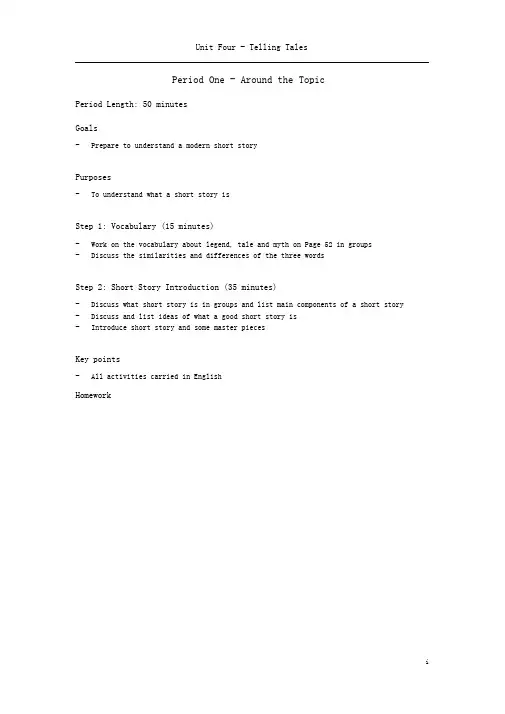
Period One - Around the TopicPeriod Length: 50 minutesGoals-Prepare to understand a modern short storyPurposes-To understand what a short story isStep 1: Vocabulary (15 minutes)-Work on the vocabulary about legend, tale and myth on Page 52 in groups-Discuss the similarities and differences of the three wordsStep 2: Short Story Introduction (35 minutes)-Discuss what short story is in groups and list main components of a short story -Discuss and list ideas of what a good short story is-Introduce short story and some master piecesKey points-All activities carried in EnglishHomeworkPeriod Two — Reading (1): Mr. JonesPeriod Length: 50 minutesGoals-Vocabulary and grammar-Discourse knowledgePurposes-Learn new words and expressions-Understand key grammar points-Understand related discourse knowledgeStep 1: Pre-reading Tasks (15 minutes)-Discuss briefly the words and the task on Page 54 in groups-Check briefly the preview results from studentsStep 2: Reading activity (Part One: 25 minutes)-Listen to the reading-Ask students to present new words and sentences in groups-Ask students to give feedbacks for the information presented-Give more explanations to the new words and sentences-Provide extra knowledge about new words-Guide more on sentences and grammarStep 3: Summarization (10 minutes)-Summarize the words and sentences-Summarize the text learntKey points-Instructions and tasks carried in English, Chinese is used only when necessaryHomework-Review the learnt sections-Preview the following parts and exercisesPeriod Length: 50 minutesGoals-Vocabulary and grammar-Discourse knowledgePurposes-Learn new words and expressions-Understand key grammar points-Understand related discourse knowledgeStep 1: Pre-reading Tasks (15 minutes)-Discuss briefly the previously learnt part for understanding-Check briefly the preview results from studentsStep 2: Reading activity (Part Two: 25 minutes)-Listen to the reading-Ask students to present new words and sentences in groups-Ask students to give feedbacks for the information presented-Give more explanations to the new words and sentences-Provide extra knowledge about new words-Guide more on sentences and grammar-Check the comprehension questions on Page 56Step 3: Summarization (10 minutes)-Summarize the words and sentences-Summarize the text learntKey points-Instructions and tasks carried in English, Chinese is used only when necessaryHomeworkReview the learnt sectionsPreview the following parts and exercisesPeriod Length: 50 minutesGoals-Enhance the vocabulary abilityPurposes-Learn detailed usage of certain words-Learn detailed usage of certain language structuresStep 1: Exercise A (15 minutes)-Work Vocabulary and Structure exercise A on Page 56 in groups -Check and compare answers in groups and negotiate them-Ask students to present their answers-Provide feedbacks for answersStep 2: Exercise B (15 minutes)-Work exercise B on Page 57 in groups-Check and compare answers in groups and negotiate them-Ask students to present their answers-Provide feedbacks for answersStep 3: Exercise C (20 minutes)-Work exercise C & D on Page 57 in groups-Check and compare answers in groups and negotiate them-Ask students to present their answers-Provide feedbacks for answersKey points-Instructions and activities be carried in EnglishHomework-Finish Writing Task on Page 58 and turn them in due next period -Prepare for the grammar and vocabulary exercisesPeriod Five Language in UsePeriod Length: 50 minutesGoals-Grammar knowledge and vocabulary buildingPurposes-Narrative Tenses-Phrasal Verbs with off and outStep 1: Narrative Tenses (30 minutes)-Test grammar knowledge on Page 59 for checking grammar abilities-Work on exercises A, B & C on Pages 59 & 60 in groups-Ask students to present their answers and provide necessary explanations -Give supplementary information on those structures if necessaryStep 2: Phrasal Verbs with off and out (20 minutes)-Work on exercises A & B on Pages 28 in groups-Ask students to present their answers and explain Compound words-Give supplementary information on Compound words if necessaryKey points-Give instructions in English-Explain grammar knowledge in ChineseHomeworkPeriod Six — Extension: The Enchanted Knife Period Length: 50 minutesGoals-Extend reading abilitiesPurposes-Apply previously learnt vocabulary and cultural knowledge in reading-Develop reading abilities-Improve abilities on negotiation and discussionStep 1: Reading (20 minutes)-Ask students to readThe Enchanted Knifeon Page 30 in groups-Understand new words and sentences within the group by negotiating in English -Finish Vocabulary Check on Page 64Step 2: Discussion (30 minutes)-Discuss questions listed on Page 64-Ask each group to present their opinions for the questions in front-Give feedbacks and remarks for presentationsKey points-Inspect group discussions and give guidance to promote discussionsHomework-Review previously learnt materials-Prepare for the ProjectPeriod Seven - Project (1): A Story of Your Own Period Length: 50 minutesGoals-Teamwork abilitiesPurposes-Apply previously learnt words and cultural knowledge into actual use-Develop teamwork abilitiesStep 1: A Make-up story (25 minutes)-Make up a strange story following the example of Mr. Jones with clue words and instructions on Page 62Step 2: An odd experience (25 minutes)-Work in groups to finish the story of An odd experience on Page 62-Ask each group to present their stories and provide remarksKey points-All preparations and negotiations be carried in English-Give guidance while students prepare the projectHomeworkPeriod Eight - Project (2): A Story of Your OwnPeriod Length: 50 minutesGoals-See abovePurposes-See aboveStep 1: Prepare for a surprise (25 minutes)-Share your stories with others and present them with pictures if possibleStep 2: Evaluate stories (25 minutes)-Give remarks to the presentations after the whole class have finished presenting stories-Group members should also talk about what they have learnt from this presentation project.Key points-Give instructions for presentationHomework-Revise writings according to the feedbacks and remarks received-Turn the revised copies before next periodPeriod Nine - Culture Tips: AthenaPeriod Length: 50 minutesGoals-Understand part of western culture from another perspectivePurposes-Help students to understand western culture-Help students to learn more cultural expressionsStep 1: Warm-up (15 minutes)-Read materials onAthena on Page 65-Help on any new words if necessaryStep 2: Open Discussion (35 minutes)-Ask students to talk more about western myths and tales if possible-Encourage students to pay more attention to the western culture while learning a languageKey points-All activities be carried in EnglishHomeworkPeriod Ten - Learning to Learn Period Length: 50 minutesGoalsPurposesStep 1Step 2Key pointsHomework。
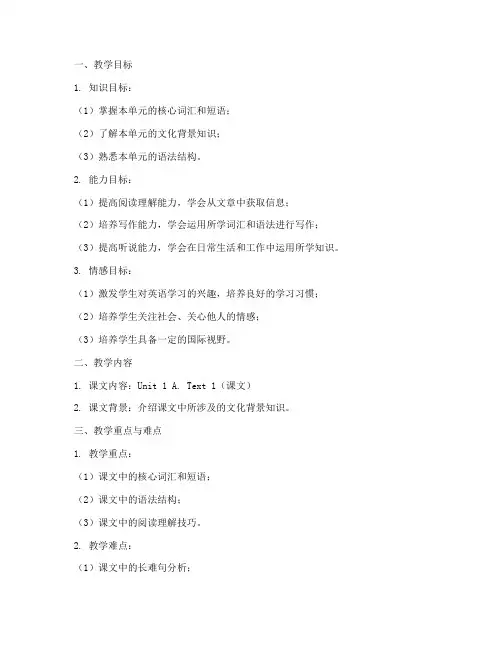
一、教学目标1. 知识目标:(1)掌握本单元的核心词汇和短语;(2)了解本单元的文化背景知识;(3)熟悉本单元的语法结构。
2. 能力目标:(1)提高阅读理解能力,学会从文章中获取信息;(2)培养写作能力,学会运用所学词汇和语法进行写作;(3)提高听说能力,学会在日常生活和工作中运用所学知识。
3. 情感目标:(1)激发学生对英语学习的兴趣,培养良好的学习习惯;(2)培养学生关注社会、关心他人的情感;(3)培养学生具备一定的国际视野。
二、教学内容1. 课文内容:Unit 1 A. Text 1(课文)2. 课文背景:介绍课文中所涉及的文化背景知识。
三、教学重点与难点1. 教学重点:(1)课文中的核心词汇和短语;(2)课文中的语法结构;(3)课文中的阅读理解技巧。
2. 教学难点:(1)课文中的长难句分析;(2)课文中的文化背景知识;(3)课文中的写作技巧。
四、教学方法1. 案例分析法:通过分析课文中的案例,引导学生理解课文内容;2. 互动式教学:鼓励学生积极参与课堂讨论,提高学生的参与度;3. 任务型教学:设计不同的任务,让学生在完成任务的过程中提高英语能力;4. 多媒体辅助教学:利用多媒体资源,丰富课堂内容,提高教学效果。
五、教学过程1. 导入新课(5分钟)(1)介绍课文背景;(2)提出本节课的学习目标。
2. 课文讲解(20分钟)(1)讲解课文中的核心词汇和短语;(2)分析课文中的语法结构;(3)分析课文中的长难句;(4)引导学生理解课文内容。
3. 阅读理解练习(10分钟)(1)布置阅读理解练习题;(2)学生独立完成练习;(3)教师讲解答案,总结阅读技巧。
4. 课堂讨论(10分钟)(1)提出与课文相关的问题;(2)学生分组讨论,分享观点;(3)教师总结讨论结果。
5. 写作练习(10分钟)(1)布置写作任务;(2)学生独立完成写作;(3)教师讲解写作技巧。
6. 课堂小结(5分钟)(1)回顾本节课所学内容;(2)布置课后作业。
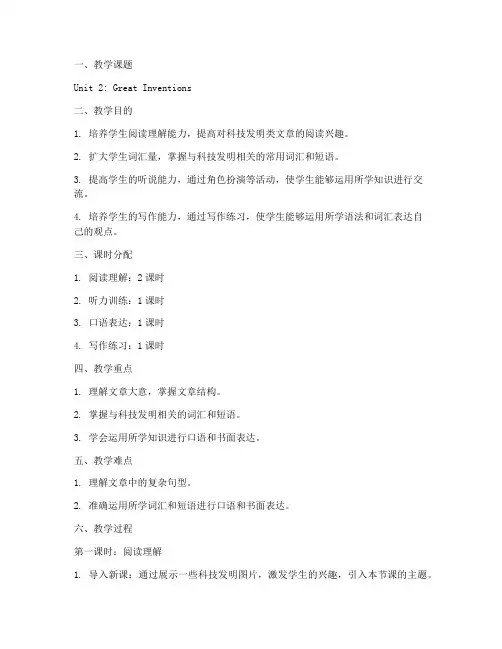
一、教学课题Unit 2: Great Inventions二、教学目的1. 培养学生阅读理解能力,提高对科技发明类文章的阅读兴趣。
2. 扩大学生词汇量,掌握与科技发明相关的常用词汇和短语。
3. 提高学生的听说能力,通过角色扮演等活动,使学生能够运用所学知识进行交流。
4. 培养学生的写作能力,通过写作练习,使学生能够运用所学语法和词汇表达自己的观点。
三、课时分配1. 阅读理解:2课时2. 听力训练:1课时3. 口语表达:1课时4. 写作练习:1课时四、教学重点1. 理解文章大意,掌握文章结构。
2. 掌握与科技发明相关的词汇和短语。
3. 学会运用所学知识进行口语和书面表达。
五、教学难点1. 理解文章中的复杂句型。
2. 准确运用所学词汇和短语进行口语和书面表达。
六、教学过程第一课时:阅读理解1. 导入新课:通过展示一些科技发明图片,激发学生的兴趣,引入本节课的主题。
2. 阅读课文:学生自主阅读课文,了解文章大意,掌握文章结构。
3. 翻译练习:学生翻译文章中的重点句子,巩固词汇和语法知识。
4. 课堂讨论:针对文章中的关键问题进行讨论,加深对文章内容的理解。
第二课时:听力训练1. 导入新课:通过播放一段与科技发明相关的英语听力材料,激发学生的兴趣。
2. 听力练习:学生听录音,回答问题,提高听力理解能力。
3. 课堂讨论:针对听力材料中的关键问题进行讨论,加深对内容的理解。
第三课时:口语表达1. 导入新课:通过展示一些科技发明图片,激发学生的兴趣,引入本节课的主题。
2. 角色扮演:学生分组进行角色扮演,模拟科技发明场景,运用所学知识进行交流。
3. 课堂讨论:针对角色扮演中的问题进行讨论,提高口语表达能力。
第四课时:写作练习1. 导入新课:通过展示一些科技发明案例,激发学生的写作兴趣。
2. 写作指导:教师讲解写作技巧,指导学生如何运用所学知识进行写作。
3. 写作练习:学生根据所学知识,撰写一篇关于科技发明的短文。
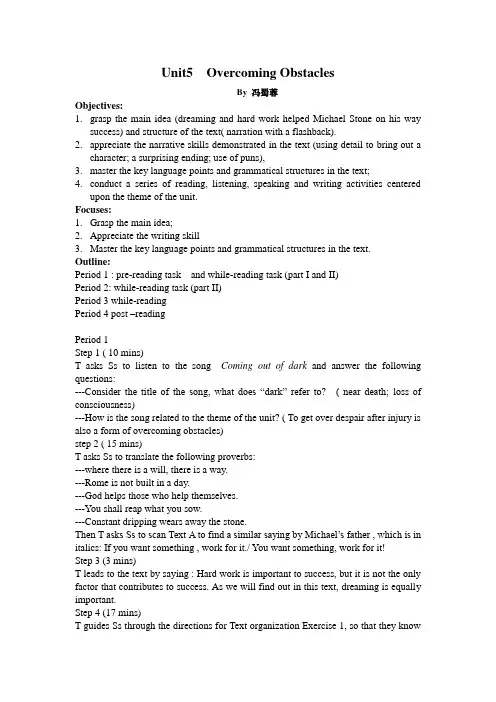
Unit5 Overcoming ObstaclesBy 冯蜀蓉Objectives:1.grasp the main idea (dreaming and hard work helped Michael Stone on his waysuccess) and structure of the text( narration with a flashback).2.appreciate the narrative skills demonstrated in the text (using detail to bring out acharacter; a surprising ending; use of puns),3.master the key language points and grammatical structures in the text;4.conduct a series of reading, listening, speaking and writing activities centeredupon the theme of the unit.Focuses:1.Grasp the main idea;2.Appreciate the writing skill3.Master the key language points and grammatical structures in the text.Outline:Period 1 : pre-reading task and while-reading task (part I and II)Period 2: while-reading task (part II)Period 3 while-readingPeriod 4 post –readingPeriod 1Step 1 ( 10 mins)T asks Ss to listen to the song Coming out of dark and answer the following questions:---Consider the title of the song, what does “dark” refer to? ( near death;loss of consciousness)---How is the song related to the theme of the unit? ( To get over despair after injury is also a form of overcoming obstacles)step 2 ( 15 mins)T asks Ss to translate the following proverbs:---where there is a will, there is a way.---Rome is not built in a day.---God helps those who help themselves.---You shall reap what you sow.---Constant dripping wears away the stone.Then T asks Ss to scan Text A to find a similar saying by Michael’s father , which is in italics: If you want something , work for it./ You want something, work for it!Step 3 (3 mins)T leads to the text by saying : Hard work is important to success, but it is not the only factor that contributes to success. As we will find out in this text, dreaming is equally important.Step 4 (17 mins)T guides Ss through the directions for Text organization Exercise 1, so that they knowthe text consists of four parts.Ss scan the first sentence of Paras. 1—6, and get ready to answer the following questions:---Which first sentence switches from past tense to past perfect tense?The first sentence of Para.3---Which first sentence shows that the flashback is over and the narration returns to the National Junior Olympics?The first sentence of Para.6----By now, do you know how to divide the text into four parts?Ss then do Text Organization Exercise 2Period 2Step 1 (45 mins)T explains language points and gives Ss practice.Period 3Step 1 (15mins)Ss sum up the mains ideas of each part .Step 2 (15 mins)Ss answer these questions---Without the last sentence, would you still admire Michael Stone’s achievement?---Who would you admire better, a Michael Stone with a sound body or a blind Michael Stone?---Why does the author keep the secret about Michael’s blindness un til the last sentence?Step 3 (15mins)Ss scan the text again to find out the three instances where “work” is used as a verb.T asks some Ss to explain in English the three different meaning of “work”.Ss do the after-text usage exercise on “ work”.Period 4Step 1Finding out details: ( 25 mins)1)T introduces the activity by saying: a child usually inherits characteristics form both his /her mother and father. So does Michael Stone. Michael’s mother is romantic and passionate, while his father is a hard-core realist. Work with a partner, find out those details about Michael Stone that shows him to be his mother’s boy or his father’s son.2) Some pairs report to the class their findings.3) T asks Ss this question: Dreaming and hard work, which is more important to Michael’s success? Why?Step 2 (15 mins)Playing on the meaning of words.1)T introduces the idea that many words have more than one meaning and canremind one of a number of different ideas and events all at once.2)Ss read the first three sentences of the text to find out where the author uses aword in two different senses.3)Ss give individual opinion on this question: How do you understand the titleof this text? Does it also carry more than one meaning?Step 3 ( 5 mins)Review the text.Period 5T checks on Ss’ exercises/Language points:1. bear out: prove that is truee.g. The evidence that the US Central Intelligence Agency has obtained bears out their claims that Bin Laden is closely related to the September 11 terrorists attacks in the USA.The witnesses will bear you out in court.2. mere: nothing more thane.g. It’s a mere 200 meters from my house to the collegeHow can you expect her to work out such a complicated math problem?. She is a mere child.3.passion: strong feeling. esp. of lovee.g. He loved her still, with the same passion as he always had.She had never before loved anyone with such passion.4.detail:go into details: explain sth. thoroughlye.g. can you give me a rough idea of what happened, without going into detail?in detail : fully or thoroughlye.g. She told them in detail what they were going to say at the meeting?5.recur: come or happen againe,g, The theme of love recurred in many of his books.The school authorities warned the student that he will be expelled if this cheating recurs.6.coincide: 1) happen at the same timee.g. His arrival in Tokyo coincided with the beginning of the war.2) be in agreemente.g. He gave great encouragement to his students, especially if their passions happened to coincide with his own.7.on one/two/several occasions: once /twice/several times in the passte.g. On several occasions, I attempted to talk with my parents about my taking a part time fob, but my mother instantly interrupted me by asking me questions about my studies.He drinks far too much. On occasion I saw him drink a whole bottle of vodka. 8.vain: too pleased with one’s own abilities or lookse,g, Too much praise can make a person vain.She was vain of her appearance.9.be ashamed of : feeling foolish or uncomfortable because ofe.g. She was so ashamed of cheating in the test that she went and told the teacher.You should be ashamed of yourself, telling lies at your age.10.along with: together withe.g. Along with hundreds of others he had invested money in stocks and bonds.I keep my checks in the top drawer, along with my other important documents.11.bring back to earth: cause … to stop day-dreaming; cause … to return to realitye.g. Emily’s voice brought him back to earth.Jack had been spending all his time chatting on line woth his key-pals until his parents had a word with him and brought him back to earth,12.media: means of mass communicatione.g. They are wondering whether bias in the news media contributed to the candidate’s defeat.Much of what children learn comes directly from the mass media.。
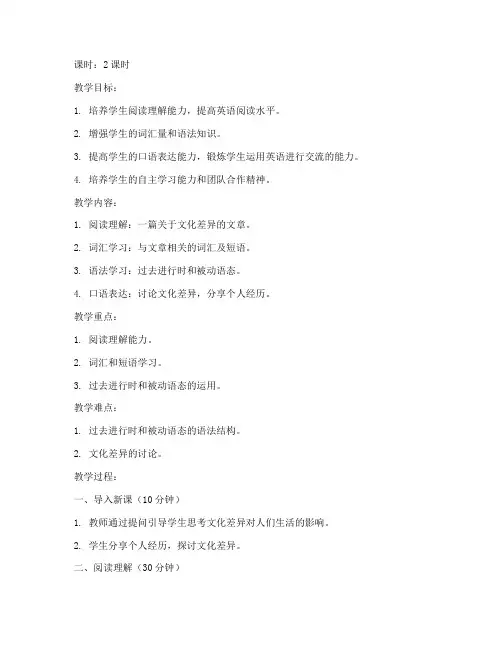
课时:2课时教学目标:1. 培养学生阅读理解能力,提高英语阅读水平。
2. 增强学生的词汇量和语法知识。
3. 提高学生的口语表达能力,锻炼学生运用英语进行交流的能力。
4. 培养学生的自主学习能力和团队合作精神。
教学内容:1. 阅读理解:一篇关于文化差异的文章。
2. 词汇学习:与文章相关的词汇及短语。
3. 语法学习:过去进行时和被动语态。
4. 口语表达:讨论文化差异,分享个人经历。
教学重点:1. 阅读理解能力。
2. 词汇和短语学习。
3. 过去进行时和被动语态的运用。
教学难点:1. 过去进行时和被动语态的语法结构。
2. 文化差异的讨论。
教学过程:一、导入新课(10分钟)1. 教师通过提问引导学生思考文化差异对人们生活的影响。
2. 学生分享个人经历,探讨文化差异。
二、阅读理解(30分钟)1. 学生阅读文章,了解文化差异的相关知识。
2. 教师讲解文章中的生词和短语,帮助学生理解文章内容。
3. 学生回答教师提出的问题,检验阅读理解效果。
三、词汇学习(15分钟)1. 教师讲解与文章相关的词汇和短语,如:culture, difference, adapt, etc.2. 学生跟读并拼写词汇,巩固记忆。
四、语法学习(15分钟)1. 教师讲解过去进行时和被动语态的语法结构,结合例句进行讲解。
2. 学生进行相关练习,巩固语法知识。
五、口语表达(30分钟)1. 学生分组讨论文化差异,分享个人经历。
2. 学生代表发言,展示讨论成果。
3. 教师点评学生的口语表达,提出改进建议。
六、课堂小结(5分钟)1. 教师总结本节课的学习内容,强调重点和难点。
2. 学生反思自己的学习情况,提出疑问。
七、布置作业(5分钟)1. 阅读教材中的相关文章,完成课后练习。
2. 复习本节课学习的词汇和语法知识。
教学评价:1. 课堂参与度:观察学生在课堂上的发言情况,评价其口语表达能力。
2. 阅读理解能力:通过课后练习和课堂提问,检验学生的阅读理解效果。
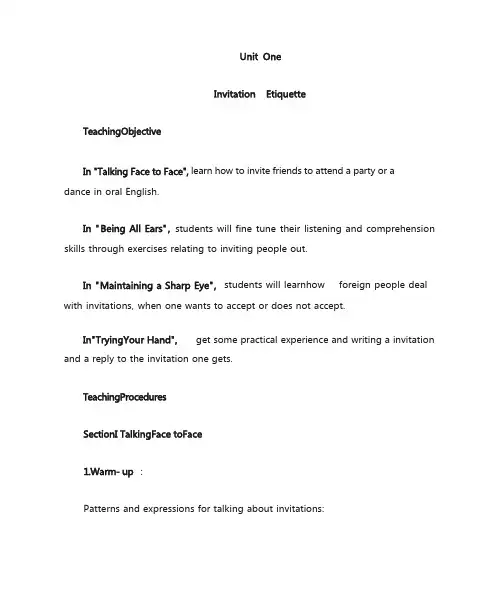
dance in oral English.students will fine tune their listening and comprehensionskills through exercises relating to inviting people out.with invitations, when one wants to accept or does not accept.and a reply to the invitation one gets.Patterns and expressions for talking about invitations:I’dliketoinviteyoutodinner.我想请你吃晚饭。
Why don’t you come and join us for disco?你为什么不和我们一起跳迪斯科?It’s very kind of you to invite me.谢谢你邀请我。
How nice of you! Many thanks.你真好!多谢。
I’dlove to. That wouldbe grea t.我很愿意去。
太好了!Oh, dear, I’m afraid I’m busy tonight. Perhaps tomorrow evening?哦,亲爱的,今晚我很忙。
明晚也许可以吧?Could you make it another time, perhaps next Sunday?你能改个时间吗,下个星期天怎样?It’s very kind of you, but you see I’ll have to prepare for my exam.非常感谢,可你知道我得准备考试。
I’m sorry I can’t, but thank you all the same.真抱歉,我不能去。
可还是要谢谢你。
Wouldyoulike to … ?您愿意…吗?I’dlike toinvite youto …我想邀请你参加…?I would like to know if you could come to …?我想知道你是否能来…May I invite you to …?敬请光临…Wouldit be possible tojoinus for… ?请问你是否能光临…?Would it be convenient to take part in …?请问你是否方便参加…?I was wondering if you would be interested in …?不知你是否有兴趣参加…?Thank you. I’ll be happy to come.谢谢.我很高兴接受你的邀请.I’dlove to. That wouldbe grea t.我很愿意去.太好了.Thank you for invitation.谢谢你的邀请.I’dbe gladtocom e.我很高兴前往.I’d love to, but I can’t come.我很想参加,但是不能来.Thank you for your invitation, but I don’t think I can make it.感谢你的邀请,但我恐怕不能赴约.Unfortunately,I’malready busy that day.很遗憾,我那天事情太多了.It’s very kind of you, but you see I’ll have to prepare for my exam.非常感谢,可你知道我得准备考试。
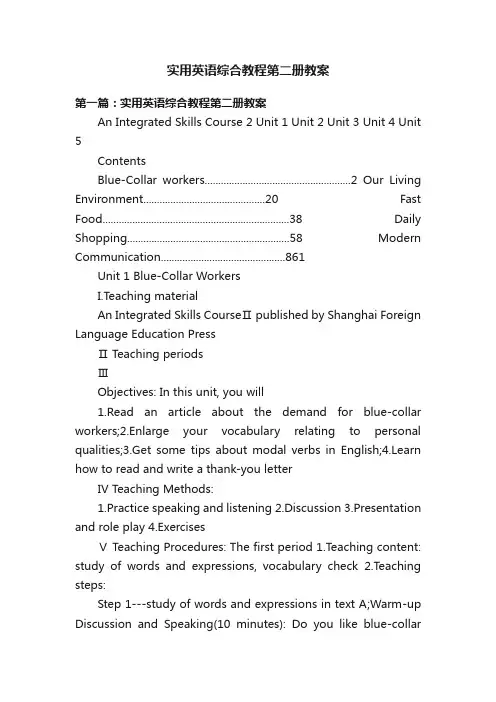
实用英语综合教程第二册教案第一篇:实用英语综合教程第二册教案An Integrated Skills Course 2 Unit 1 Unit 2 Unit 3 Unit 4 Unit 5ContentsBlue-Collar workers......................................................2 Our Living Environment.............................................20 Fast Food.....................................................................38 Daily Shopping............................................................58 Modern Communication. (861)Unit 1 Blue-Collar WorkersI.Teaching materialAn Integrated Skills CourseⅡ published by Shanghai Foreign Language Education PressⅡ Teaching periodsⅢObjectives: In this unit, you will1.Read an article about the demand for blue-collar workers;2.Enlarge your vocabulary relating to personal qualities;3.Get some tips about modal verbs in English;4.Learn how to read and write a thank-you letterⅣ Teaching Methods:1.Practice speaking and listening2.Discussion3.Presentation and role play4.ExercisesⅤ Teaching Procedures: The first period 1.Teaching content: study of words and expressions, vocabulary check 2.Teaching steps:Step 1---study of words and expressions in text A;Warm-up Discussion and Speaking(10 minutes): Do you like blue-collarjobs? What is your favorite blue-collar job and why?Hints: I like blue-collar jobs because(1)the demand is huge;(2)you can get professional training and technical knowledge;(3)the salary is goodMy favorite blue-collar job is that of a gardener, because(1)I can work outdoors and enjoy the fresh air;and(2)I can keep fit and get good pay(The students will probably have trouble with English expressions relating to blue-collar jobs.The teacher may allow the students to answer this question in Chinese, and then give the students key terms in English and ask them to express their ideas again in English.)Background Information(5 minutes)Blue-collar workers(TB P2)Different categories of jobs(blue-collar/golden-collar/pink-collar/grey-collar/white-collar)Introduce new words on board:(20 minutes)heartland resident workforcereplacementreplaceshortage manufacturermanufacture remarkable recoveryannualearnings earnpoint togap high-end decline expand certificateprograminvestmentinvest find a way upStep 2—Practice: Vocabulary Check and Oral English(10 minutes)Give students 5 minutes to finish exercises A in Page 9Everyday English 1.If you want to stop someone and ask him/her for directions, what do you usually say to him/her first?(Excuse me.)2.If you don’t quite understand what the person has told you about the directions, what can you do?(Although one can always say “I beg you pardon?” or “Could you say it again?” try not to make the person repeat more than twice.Instead, you may repeat what you’ve already understood and let the person tell you the test.)3.While traveling in a foreign country, what would you bring along to make your travel easier?(A road map.)The second period 1.Teaching content: Discussion and Comprehensive of Text A 2.Teaching steps:Step 1---Warm up(10 minutes)(invite some students to explain the meaning of the difficult sentences of the text A in English or in Chinese, teacher may give them some hints.) Step2---Language Points(25 minutes)1)To many… offer its residen ts: For many people, America’s industrial heartland can’t provide enough work to its residents.too little: not too much, not enough 太少Too much work and too little rest often lead to illness.过量的工作和过少的休息会引起疾病。
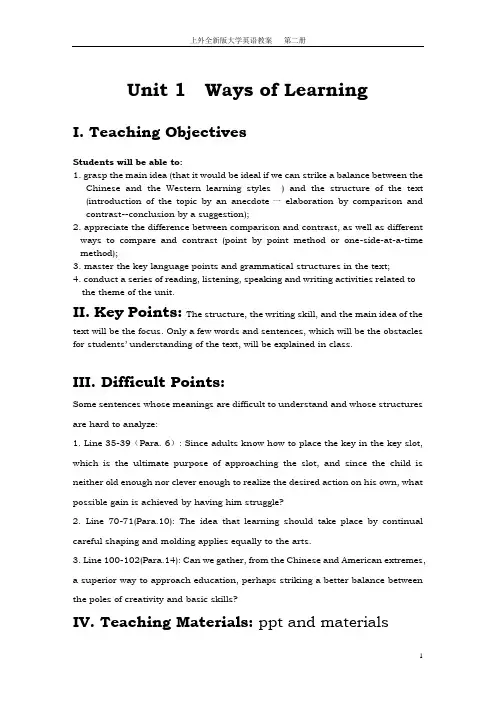
Unit 1 Ways of LearningI. Teaching ObjectivesStudents will be able to:1. grasp the main idea (that it would be ideal if we can strike a balance between theChinese and the Western learning styles ) and the structure of the text (introduction of the topic by an anecdote一elaboration by comparison and contrast--conclusion by a suggestion);2. appreciate the difference between comparison and contrast, as well as different ways to compare and contrast (point by point method or one-side-at-a-time method);3. master the key language points and grammatical structures in the text;4. conduct a series of reading, listening, speaking and writing activities related to the theme of the unit.II. Key Points: The structure, the writing skill, and the main idea of thetext will be the focus. Only a few words and sentences, which will be the obstacles for students’ understanding of the text, will be explained in class.III. Difficult Points:Some sentences whose meanings are difficult to understand and whose structuresare hard to analyze:1. Line 35-39(Para. 6): Since adults know how to place the key in the key slot,which is the ultimate purpose of approaching the slot, and since the child isneither old enough nor clever enough to realize the desired action on his own, whatpossible gain is achieved by having him struggle?2. Line 70-71(Para.10): The idea that learning should take place by continualcareful shaping and molding applies equally to the arts.3. Line 100-102(Para.14): Can we gather, from the Chinese and American extremes,a superior way to approach education, perhaps striking a better balance betweenthe poles of creativity and basic skills?IV. Teaching Materials: ppt and materialsV. Teaching Methods: Lecturing, practicing and discussing.VI. Teaching Timing: 8 sessions of classVII. Teaching Process:1st -2nd periods:Pre-reading; Teacher’s Introductory Remarks and Students’ Discussion related to the topic.3rd -4th periods: While-Reading (Understanding the title of text A; Analyzing the organization of the text; Explaining Difficult sentences and language points in the text; Summing up the main idea of the text)5th-6th periods: Dealing with the exercises after Text A. Check on Ss’ home reading (Text B); Post-Reading Task: Theme-Related Language Learning Tasks7th-8th periods: Listening and speaking tasks.A. Pre-reading tasksPre-reading tasks1.T asks Ss the following questions. The first is based on the song. Teach YourChildren: (5minutes )According to the song, who should teach whom? Is learning a one-way street?(Parents and children should teach each other and learn from each other. Learning is a two-way interaction.)Can you guess what the theme of this unit, ways of learning, refers to? (Different people have different learning styles)2. Ss listen to the fo11owing quotation from《文汇读书周报》(2001年12月1日第一版,"自主教育:“管”还是“不管”?) take some notes and then T will invite some Ss to summarize in English how Chen Yu hua’s parents handle her education.一本由中国经济出版社推出的《千万别管孩子一一自主教育哈佛启示录》的书近来极为畅销,问世才一月,在全国销售量已达到20余万册。
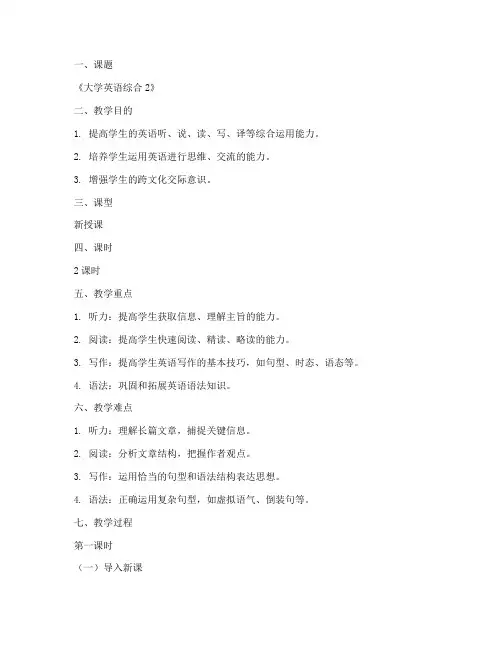
一、课题《大学英语综合2》二、教学目的1. 提高学生的英语听、说、读、写、译等综合运用能力。
2. 培养学生运用英语进行思维、交流的能力。
3. 增强学生的跨文化交际意识。
三、课型新授课四、课时2课时五、教学重点1. 听力:提高学生获取信息、理解主旨的能力。
2. 阅读:提高学生快速阅读、精读、略读的能力。
3. 写作:提高学生英语写作的基本技巧,如句型、时态、语态等。
4. 语法:巩固和拓展英语语法知识。
六、教学难点1. 听力:理解长篇文章,捕捉关键信息。
2. 阅读:分析文章结构,把握作者观点。
3. 写作:运用恰当的句型和语法结构表达思想。
4. 语法:正确运用复杂句型,如虚拟语气、倒装句等。
七、教学过程第一课时(一)导入新课1. 回顾上节课所学内容,引导学生进行复习。
2. 通过图片、视频等生动有趣的方式,激发学生学习兴趣。
(二)听力训练1. 学生自主完成听力练习,教师点评。
2. 播放听力材料,学生跟读,教师纠正发音和语调。
(三)阅读训练1. 学生自主阅读课文,教师提问检查阅读效果。
2. 分析文章结构,引导学生理解作者观点。
(四)写作训练1. 学生根据所学知识,完成写作练习。
2. 教师点评,指出写作中的不足,指导学生修改。
第二课时(一)复习上节课所学内容1. 学生回顾上节课所学知识,教师提问检查。
2. 针对上节课的不足,进行巩固练习。
(二)语法讲解1. 教师讲解本节课的语法知识点,如虚拟语气、倒装句等。
2. 学生跟随教师进行语法练习。
(三)听力训练1. 学生自主完成听力练习,教师点评。
2. 播放听力材料,学生跟读,教师纠正发音和语调。
(四)阅读训练1. 学生自主阅读课文,教师提问检查阅读效果。
2. 分析文章结构,引导学生理解作者观点。
(五)写作训练1. 学生根据所学知识,完成写作练习。
2. 教师点评,指出写作中的不足,指导学生修改。
八、板书设计1. 听力:获取信息、理解主旨2. 阅读:快速阅读、精读、略读3. 写作:句型、时态、语态4. 语法:虚拟语气、倒装句九、教具1. 多媒体设备2. 听力材料3. 课文4. 写作练习册十、作业布置1. 复习本节课所学内容,完成课后练习。
综合教程第二册教学设计教学背景综合教程第二册是一本高中英语教材的第二册,主要面向高二学生。
本册教材共分为8个模块,包括听说、读写和文化等多个方面。
本次教学设计主要针对本册课程中的第一个模块——听力。
教学目标1.能够听懂本册课程中的日常对话、短文及公告等内容。
2.能够准确理解所听内容的关键词、主题、细节等信息。
3.能够通过听力练习来提高自己的听力水平。
教学内容本次教学设计的主要内容为综合教程第二册中第一个模块——听力。
根据课程要求,本次教学将包括以下内容:1.听力技巧的讲解:介绍如何在听力过程中提高自己的听力水平,包括注意力集中、听力材料的筛选等方面。
2.听力练习的实践:通过一系列有针对性的听力练习来加强学生的听力技能,包括听短文、对话、新闻等内容,以及对听力细节的把握。
3.听力测验的评估:通过一套综合测试题对学生的听力水平进行评估,包括听力理解、听力策略运用等方面。
教学活动活动一:听力技巧的讲解1.任务要求:学生阅读课本相关章节,并通过发言、讨论等方式来了解听力技巧。
2.活动流程:分组讨论,组长汇报小组讨论结果。
活动二:听力练习的实践1.任务要求:老师播放一段短文或对话,学生在听完后作笔记并回答相应问题。
2.活动流程:分组听力练习并交流小组答案。
活动三:听力测验的评估1.任务要求:老师放一段短文或对话,学生在听完后完成相关题目。
2.活动流程:个人完成测验,并老师讲解答案。
教学效果评估1.听力技巧掌握:学生是否能够在听力过程中注意力集中、有效记笔记等。
2.听力水平提高:学生是否能够听懂所听内容的关键词、主题、细节等信息。
3.满意度评估:通过学生的反馈来评估教学效果。
教学反思通过本次教学设计,发现学生的听力水平普遍较低,对所听内容的理解度有待提高。
在今后的教学过程中,应以听力技巧与实践为主线,突出强化学生的听力能力。
同时,针对听力薄弱的学生给予更多的听力指导,帮助他们提升听力水平,更好的完成学习任务。
教学目标:1. 通过本节课的学习,学生能够理解文章的主旨大意,掌握文章的结构和写作手法。
2. 学生能够运用所学词汇和句型,进行日常生活中的交际。
3. 学生能够提高阅读理解能力,培养良好的阅读习惯。
教学内容:1. 文章主旨大意2. 文章结构3. 关键词汇和句型4. 阅读技巧教学过程:一、导入1. 利用图片、视频等形式,激发学生的学习兴趣,引出本节课的主题。
2. 提问:你们认为友谊的重要性是什么?为什么?二、课文阅读1. 学生自读课文,初步了解文章大意。
2. 教师引导学生分析文章结构,讲解文章的写作手法。
3. 学生再次阅读课文,重点关注关键词汇和句型,做好笔记。
三、词汇学习1. 教师带领学生学习本节课的关键词汇,如:friendship、importance、benefit、confident、communicate等。
2. 学生通过造句、翻译等方式,巩固所学词汇。
四、句型练习1. 教师讲解本节课的关键句型,如:What's the importance of friendship? How can we communicate with others?2. 学生进行句型练习,提高口语表达能力。
五、阅读技巧1. 教师讲解阅读技巧,如:skimming、scanning、predicting等。
2. 学生进行阅读练习,提高阅读理解能力。
六、课堂活动1. 小组讨论:学生分组讨论友谊的重要性,分享自己的观点。
2. 角色扮演:学生分组进行角色扮演,模拟日常生活中的交际场景。
七、总结1. 教师对本节课的内容进行总结,强调友谊的重要性。
2. 学生分享自己的学习心得,提出疑问。
教学评价:1. 学生对本节课的参与度、学习效果。
2. 学生对友谊重要性的认识,以及口语表达能力的提高。
3. 学生对阅读技巧的掌握程度。
教学反思:1. 本节课是否达到了预期的教学目标?2. 学生在课堂上的表现如何?3. 教学方法是否合理,是否需要调整?教学资源:1. 教科书《大学英语综合教材2》2. 图片、视频等辅助教学资源3. 课堂活动所需道具教学时间:2课时。
一、教学目标1. 知识目标:(1)掌握本单元的基本词汇和短语;(2)了解本单元的主要语法点;(3)提高学生的阅读理解能力。
2. 能力目标:(1)提高学生的听说能力,包括口语表达和听力理解;(2)提高学生的写作能力,包括书面表达和翻译能力;(3)培养学生的自主学习能力。
3. 情感目标:(1)激发学生对英语学习的兴趣,提高学习积极性;(2)培养学生的团队协作精神,提高人际沟通能力;(3)培养学生的跨文化交际意识。
二、教学内容1. 词汇:本单元涉及的基本词汇和短语;2. 语法:时态、语态、虚拟语气等;3. 阅读理解:一篇课文,要求学生理解文章大意,把握文章结构,分析作者观点;4. 听力:一段对话或短文,要求学生获取信息,理解主旨大意;5. 写作:一篇短文,要求学生运用所学知识进行写作;6. 翻译:一段汉译英或英译汉的句子或段落。
三、教学过程1. 导入新课(1)利用图片、视频等多媒体手段导入新课,激发学生的学习兴趣;(2)简单介绍本单元的主题和主要内容。
2. 词汇教学(1)展示本单元的基本词汇和短语,让学生自主阅读;(2)教师引导学生进行词汇的拼写、发音和用法练习;(3)进行词汇测试,巩固所学词汇。
3. 语法教学(1)讲解本单元的语法点,如时态、语态、虚拟语气等;(2)结合例句,让学生进行语法练习;(3)进行语法测试,巩固所学语法知识。
4. 阅读理解(1)学生自主阅读课文,了解文章大意;(2)教师引导学生分析文章结构,把握作者观点;(3)进行阅读理解测试,检验学生的学习效果。
5. 听力训练(1)播放对话或短文,让学生获取信息;(2)教师讲解听力技巧,引导学生进行听力练习;(3)进行听力测试,提高学生的听力水平。
6. 写作训练(1)教师讲解写作技巧,指导学生进行写作;(2)学生进行写作练习,教师批改并给予反馈;(3)进行写作测试,检验学生的写作能力。
7. 翻译练习(1)教师讲解翻译技巧,指导学生进行翻译练习;(2)学生进行翻译练习,教师批改并给予反馈;(3)进行翻译测试,提高学生的翻译能力。
新通用大学英语综合教程第2册教学设计一、教学背景新通用大学英语综合教程是适用于全国高等院校英语教育课程的一套教材,由高等教育出版社出版。
本文针对该教材的第2册设计一份教学计划,旨在提高学生的英语综合能力和对文化背景的理解。
二、教学目标本教学设计的目标是:1.提高学生的英语听、说、读、写的综合能力;2.增加学生对英语国家文化的了解,尤其是美国、英国和澳大利亚等国家;3.培养学生的批判性思维和独立思考能力。
三、教学内容和方法1. 教学内容本教学设计的内容主要包括教材第2册的Unit 1和Unit 2,其中包括以下课文:•Unit 1: A New Lease on Life•Unit 2: Extreme Sports此外,还可以补充一些与课本相关的阅读材料、听力材料以及视频材料,以提高学生对英语国家文化的了解。
2. 教学方法•课堂讲授和学生讨论:教师可以针对每个单元的主题进行课堂讲授和学生讨论,鼓励学生参与其中,提高课堂互动性和学生参与度。
•听力训练:结合教材和外部资源,教师可以设计一些听力练习,以提高学生的听力理解能力。
•阅读训练:教师可以在课堂上适当地布置一些作业或者课下阅读,以提高学生的阅读理解能力。
•写作训练:教师可以组织一些写作练习,如作文、读后感、书评等,以提高学生的写作水平和写作能力。
•视听学习:教师可以将一些与课本相关的视频资源放到课堂上进行观看和学习,以提高学生的视听理解能力。
四、教学评价与反馈为了更好地了解学生的学习情况,教师可以采用以下措施进行评价和反馈:1.在课堂上进行随堂测试、口语练习、写作练习等,及时反馈学生的学习进度;2.布置课后作业,鼓励学生自主学习;3.定期回顾和总结课堂内容,检验学生掌握程度;4.鼓励学生积极参加课外活动,如英语角、辩论赛等,提高综合英语能力。
五、教学资源为了更好地进行教学,教师可以利用以下资源:1.教材:《新通用大学英语综合教程第2册》2.阅读材料:如报刊、杂志、网络资源等;3.视听材料:如电影、纪录片、广告等;4.网络资源:如MOOC、学习社区、在线字典等。
教学目标:1. 培养学生阅读理解能力,使学生能够理解文章大意和细节。
2. 增强学生的词汇量和语法知识,提高英语综合运用能力。
3. 培养学生的听说能力,提高口语表达和听力理解水平。
4. 培养学生的写作能力,使学生能够撰写一篇结构完整、内容丰富的短文。
教学重点:1. 理解文章大意和细节。
2. 掌握文章中的关键词汇和语法结构。
3. 提高听说能力,能够进行简单的日常对话。
4. 提高写作能力,能够撰写一篇符合要求的短文。
教学难点:1. 理解文章中的复杂句型。
2. 掌握文章中的生僻词汇和短语。
3. 进行有效的口语表达和听力理解。
教学过程:一、导入新课1. 利用多媒体展示与文章主题相关的图片或视频,激发学生的兴趣。
2. 引导学生思考与文章主题相关的问题,如:What is the main idea of this article? What are the key points in this article?二、阅读理解1. 让学生快速阅读文章,了解文章大意。
2. 针对文章中的生僻词汇和短语进行讲解,帮助学生理解。
3. 让学生细读文章,回答问题,巩固阅读理解能力。
三、词汇和语法1. 教师讲解文章中的关键词汇和短语,让学生跟读并掌握。
2. 介绍与文章主题相关的语法知识,如:被动语态、虚拟语气等。
3. 学生进行相关练习,巩固所学词汇和语法知识。
四、听说训练1. 学生进行角色扮演,模拟文章中的场景,提高口语表达能力。
2. 教师播放听力材料,让学生回答问题,提高听力理解能力。
五、写作训练1. 教师讲解写作要求,如:文章结构、内容要求等。
2. 学生根据所学内容,撰写一篇短文,教师进行点评和指导。
六、课堂小结1. 回顾本节课所学内容,强调重点和难点。
2. 布置课后作业,如:阅读相关文章、完成写作练习等。
教学反思:1. 本节课通过多种教学方法,如:多媒体展示、角色扮演、听力训练等,激发了学生的学习兴趣,提高了他们的英语综合运用能力。
致⽤英语综合教程综合英语2教案unit.docSection One Around the topicStep 1 Topic introduction:Many Chinese students find it very difficult to introduce Chinese culture to foreign friends.The biggest problem is that they don’t know how to express their understanding about Chinese culture or how to explain some typical concepts in Chinese culture. Chinese learners of English as a foreign language should not only study western cultures, but also deepen their understanding of Chinese culture, so that they can introduce it to the outside word.Step 2 Your ideasWork in groups or pairs and discuss the following questions1)Why is spring Festival so important for the Chinese people?2)What do you usually do during the Spring Festival3)Are there any special celebration activities in your hometown during Spring Festival?4)In what ways do you think the Spring Festival has Changed?How much do you know about the Chinese New Year?A.Which day in the 15-day celebration is for the sons-in-laws to pay a visit to theirparents-in-law?The third and fourth days.B. What is the fifth day called?Po Woo.C. How many kinds of traditional New Year food do you know?Dumplings, a whole fish, chicken, New Year cake…D. Do we use knives or scissors on New Year's Day?NO. They may cut off fortune.E. What fruit do we usually use as a decoration during the Spring Festival?Oranges and Tangerines. They are symbols for abundant happiness.Step 3 VocabularyThere are some special things about Spring Festival, which are difficult to translate into English. Here are some English words and expressions related to the Spring Festival. Try to get their meanings.Remind students that names of some typical Chinese things do not have exact equivalents in English. Ask them to guess the meaning of the English words and phrases related to theThe teacher can offer students a particular situation for students to practice in which students can give a brief talk with some of the words in the table above so that they can master a better usage of these words.Step 4 Listening and speakingAsk students to read the questions first. Then play the recording and encourage them to take notes while listening.1.Q: What are they talking about?A: They are talking about the Spring Festival.2.Q: How did Li Ming spend his holiday?A: Li Ming spent his holiday with his family in his hometown.3.Q: What is Susan curious about?A: Susan is curious about how Chinese people celebrating their Spring Festival.4.Q: What make the Spring Festival different from other holidays?A: Giving presents and staying with the family.5.Q: What do Chinese People do on the Eve of the Spring Festival according to the recording?A: In the past, all the members of a family would stay at home making dumplings together.Now many people enjoy watching TV. During the day, children wear their new clothes. The evening is usually spent playing games, talking, eating and drinking.Step 5 A quizDuring the Spring Festival, some things are believed to bring good luck for the new year, while other things might bring bad luck. Read the items in the table below and decide whether they bring good luck or bad luck. When you finish, compare your answers in pairs.This quiz is just for fun. Remind students that we should not be superstitious and the dos and don’ts during the Spring Festival are only parts of our traditions and customs. We should hold a right attitude towards them.Ask students to do the exercise first based on their own understanding and then compare their answers with their partners’. They may discuss them if necessary. When they finish, you may show and explain answers.Section Two ReadingThis section introduces the tradition of the Chinese New Year. By studying it, students will learn more about the legend of Nian and traditional Chinese New Year celebration activities. Most importantly, students will learn how to introduce the Chinese New Year to foreign friends.Step 1 Pre-reading tasksBefore you read, discuss the following questions in groups:1.Do you know why we call the Spring Festival “Nian”?2.Do you know why we Chinese celebrate the New Year at a different time from the Westernworld?Read the instruction as a class. Divide students into groups. Ask them to discuss the questions. Activate their prior knowledge of the Spring Festival and encourage them to share informationwith others. Pick some volunteers to answer these tow questions as representatives of their group. Step 2 Text illumination 1)Ask several students to read the whole text in order to check whether they preview thetext and get a general understanding bout it or not beforehand.2)Ask students to summarize the text3)The teacher can put the comprehension check either before or after illuminating the textaccording to the needs of class and the students’ comprehension ability.4)Illuminate the text, during the process of which the teacher can encourage students tohighlight or underline the important parts when they read the text in detail. Try to explain that it can help students to grasp theimportant details and review important points Language points:1. legend n.story handed down from the past, especially one that may not be true 传奇,传说e.g. The legend of Robin Hood is well-known.2. mythical adj. existing only in an ancient story, imagined or invented 神话的,虚构的e.g. Qi Lin is a mythical Chinese creature which is similar to a unicorn.myth n. 神话e.g. ancient Greek myths3. terrorise v. to fill or overpower with terror, to terrify 使惊恐不安,恐吓e.g. The local gangs terrorised the neighborhood.4. fierce adj. violent and angry 凶猛的,凶狠的e.g. Swans are always fierce in defense of their young.The leopard looks fierce.5. lunar adj. determined or measured in reference to the moon 根据⽉亮决定或测定的e.g. The Chinese New Year falls on lunar January, 1st.6. solar adj. determined or measured in reference to the sun 根据太阳决定或测定的e.g. Solar energy is one kind of important energy nowadays.7. insert v. to put or set into, between, or among 插⼊,嵌⼊e.g. The editor inserted an advertisement in the newspaper.insert a key into a lock8. symbolic adj. representing a particular idea or quality 象征的,符号的e.g. The cross is symbolic of Christianity9. ward off to keep away (somebody/something that is dangerous or unpleasant) 挡开,避开e.g. He carried a gun to ward off possible attacks.Step 3 Post-reading exercises1.What is the significance of the following things during the Spring Festival?2.Discussion:Read the instruction as a class. Divide students into groups of four. Ask them to discuss these questions. Get feedback when they finish. Try to encourage them to express their opinions thoroughly in English.3.V ocabulary and structureThis part is about some vocabulary and structure exercises related to the text. Ask students to finish them independently beforehand. Check their answers in class. Try to encourage them to explain by themselves to check whether they fully understand the exercises or not. The teacher is supposed to give some explanations if necessary.A.Work out the meanings of the underlined words with the help of the context.B.Fill in the blanks with the words below. Change the form where necessary./doc/4b8dffd1f68a6529647d27284b73f242326c3101.html plete each pair of the sentences with the correct form of the same verb, one as apresent participle (-ing) and the other as a past participle (-ed).4.WritingRead the instruction as a class. Leave the writing task as homework. Check their work next time.Write down your experience about the Spring Festival. The following questions may help you to come up with some ideas.1)How does your family prepare for the Spring Festival?2)What traditional activities does your family do to celebrate the Spring Festival?3)What special activity do you like most when you are celebrating the Spring Festival?Section Three language in use: present participles used as adverbialsStep 1 test your grammarThe aim of this practice is to make students aware of the present participles used as adverbials. Based on their study of the text, they may gain a deeper understanding by doing these exercises. Try to encourage students to explain by themselves through recalling and understanding of this grammatical phenomenon.Step 2 illumination and developmentBriefly explain the grammatical knowledge of participles. Then ask students to finish these exercises. Check their work when they finish.⼀、现在分词做状语(表原因,时间,条件,让步,⾏为⽅式,伴随状况)现在分词与主句的主语⼀致,且形成主谓关系,就是说现在分词的动作发出者是主句的主语。
教案课程名称:综合英语II年月日课题Unit 1 Understanding Chinese Culture-Part One教学目的In this unit, the students will learn:The origin and traditions of the Chinese New YearHow to use present participles as adverbialsHow to introduce Chinese New Year traditions to foreign friends教学重点、难点The important points:The words and expressions of this unitUsing present participles as adverbialsThe difficult points:The traditions of Chinese and western traditions of some festivalsLearn to introduce Chinese New Year traditions to foreign friends教学方法Lecturing method教学设备与器材Multi-media equipment课时量2 periods教案续页第页年月日课题Unit 1 Understanding Chinese Culture-Part Two教学目的In this unit, the students will learn:The origin and traditions of the Chinese New YearHow to use present participles as adverbialsHow to introduce Chinese New Year traditions to foreign friends教学重点、难点The important points:The words and expressions of this unitUsing present participles as adverbialsThe difficult points:The traditions of Chinese and western traditions of some festivalsLearn to introduce Chinese New Year traditions to foreign friends教学方法Lecturing method教学设备与器材Multi-media equipment课时量2 periods教案续页第页年月日课题Unit 2 Feel Free to Inquire-Part One教学目的In this unit, the students will learn:The importance of being inquisitiveHow to be an inquisitive personHow to use the structures of so that and so…thatThree types of compound words教学重点、难点The important points:The words and expressions of this unitUsing three types of compound wordsThe difficult points:The discussion of the importance of being inquisitiveLearn to use the structures of so that and so…that教学方法Lecturing methodGroup activity教学设备与器材Multi-media equipment课时量4 periods教案续页第页教案续页第页年月日课题Unit 2 Feel Free to Inquire-Part Two教学目的In this unit, the students will learn:The importance of being inquisitiveHow to be an inquisitive personHow to use the structures of so that and so…thatThree types of compound words教学重点、难点The important points:The words and expressions of this unitUsing three types of compound wordsThe difficult points:The discussion of the importance of being inquisitiveLearn to use the structures of so that and so…that教学方法Lecturing methodGroup activity教学设备与器材Multi-media equipment课时量4 periods教案续页第页年月日课题Unit 3 Manage Your Time-Part One教学目的In this unit, the students will learn:Manage your time efficientlyUnderstand the 80/20 principleHow to use will correctly教学重点、难点The important points:The words and expressions of this unitUsing the modal word will correctlyThe difficult points:The discussion of the importance of being in timeLearn to use the time management principle教学方法Group activityLecturing method教学设备与器材Multi-media equipment课时量4 periods教案续页第页教案续页第页教案续页第页年月日课题Unit 3 Manage Your Time-Part Two教学目的In this unit, the students will learn:Manage your time efficientlyUnderstand the 80/20 principleHow to use will correctly教学重点、难点The important points:The words and expressions of this unitUsing the modal word will correctlyThe difficult points:The discussion of the importance of being in timeLearn to use the time management principle教学方法Group activityLecturing method教学设备与器材Multi-media equipment课时量4 periods教案续页第页教案续页第页年月日课题Unit 4 Telling Tales教学目的In this unit, the students will learn:Read different types of storiesDescribe appearance by using appropriate adjectivesExpress interest and surpriseUse narrative tenses教学重点、难点The important points:The words and expressions of this unitRead different types of storiesThe difficult points:Use narrative tensesLearn to express interest and surprise教学方法Lecturing method教学设备与器材Multi-media equipment课时量6 periods教案续页第页教案续页第页年月日课题Unit 5 Relationships-Part One教学目的In this unit, the students will learn:Show appreciation to those who are closeMaintain a close relationship with othersUse a relative pronoun what and whichTalk about relationships among various people教学重点、难点The important points:The words and expressions of this unitUse a relative pronoun what and whichThe difficult points:Talk about relationships among various peopleShow appreciation to those who are close教学方法Lecturing methodGroup activity教学设备与器材Multi-media equipment课时量4 periods教案续页第页年月日课题Unit 5 Relationships-Part Two教学目的In this unit, the students will learn:Show appreciation to those who are closeMaintain a close relationship with othersUse a relative pronoun what and whichTalk about relationships among various people教学重点、难点The important points:The words and expressions of this unitUse a relative pronoun what and whichThe difficult points:Talk about relationships among various peopleShow appreciation to those who are close教学方法Lecturing methodGroup activity教学设备与器材Multi-media equipment课时量4 periods教案续页第页课题Unit 6 Crime and Security-Part One教学目的In this unit, the students will learn:Talk about crime and security issuesCarry out an investigation on neighborhood security Use modal verbs to express possibility and probability教学重点、难点The important points:The words and expressions of this unitCarry out an investigation on neighborhood securityThe difficult points:Talk about crime and security issuesUse modal verbs to express possibility and probability教学方法Lecturing methodGroup activity教学设备与器材Multi-media equipment课时量4 periods教案续页第页年月日课题Unit 6 Crime and Security-Part Two教学目的In this unit, the students will learn:Talk about crime and security issuesCarry out an investigation on neighborhood securityUse modal verbs to express possibility and probability教学重点、难点The important points:The words and expressions of this unitCarry out an investigation on neighborhood securityThe difficult points:Talk about crime and security issuesUse modal verbs to express possibility and probability教学方法Lecturing methodGroup activity教学设备与器材Multi-media equipment课时量4 periods教案续页第页年月日课题Unit 7 Men and Women-Part One教学目的In this unit, the students will learn to:Talk about differences between men and women;Describe a person’s personality;Use expressions to emphasize emotions.教学重点、难点The important points:The words and expressions of this unitCarry out an investigation on gender differencesThe difficult points:Talk about men and women issuesUse different words to express emotions and personalities.教学方法Lecturing methodGroup discussion教学设备与器材Multi-media equipment课时量4 periods教案续页第页。